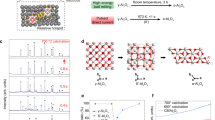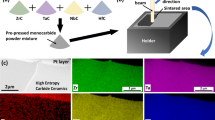Abstract
TiO2 nanoparticles with enhanced solid solution of Cr up to 16 wt% in polymorphs of rutile, anatase, brookite, α-PbO2-type, and occasionally baddeleyite-type were synthesized via pulse laser ablation on ceramic TiO2 target dissolved with Cr2O3 or clamped Cr/Ti plates in air. Analytical electron microscopic observations indicated these nanocondensates have prevalent crystallographic shear (CS) along specific planes to form superstructures. The rutile type typically shows (100) and (010) CS besides the conventional ones rotating about the [111] zone axis as reported for ambient samples. The CS planes are parallel to (001) for anatase, (001) and (\( \overline{1} \)10) for brookite, whereas (001) and {1\( \overline{3} \)1} for the α-PbO2-type TiO2 with varied extent of Cr dissolution. Surface modification, as a result of Cr dissolution and/or internal stress, was observed for all the polymorphs.











Similar content being viewed by others
References
Andersson S (1960) The crystal structure of Ti5O9. Acta Chem Scand 14:1161–1172
Bhattacharya P, Rasmi RD, Katiyar RS (2003) Fabrication of stable wide-band-gap ZnO/MgO multilayer thin films. Appl Phys Lett 83:2010–2012
Bursill LA, Hyde BG (1971) Crystal structure in the 132 family of higher titanium oxides Ti n O2n−1. Acta Crystallogr Sect B 27:210–215
Bursill LA, Hyde BG (1972) Crystallographic shear in the higher titanium oxides: structure, texture, mechanisms and thermodynamics. Prog Solid State Chem 7:177–182
Bursill LA, Hyde BG, Philp DK (1971) New crystallographic shear families derived from the rutile structure, and the possibility of continuous ordered solid solution. Phil Mag 23:1501–1513
Chen CH (2010) Dynamic condensation/decomposition and optical properties of Cr-dissolved TiO2 with rutile and post-rutile structures. MS thesis, National Sun Yat-sen University, Taiwan
Chen SY, Shen P (2002) Laser ablation condensation of α-PbO2-type TiO2. Phys Rev Lett 89:096106
Chen SY, Shen P (2004) Laser ablation condensation and transformation of baddeleyite-type related TiO2. Jpn J Appl Phys 43:1519–1524
Chen T, Shen P (2009) Defect clustering and ordering in Zn-doped TiO2 upon solution annealing. J Phys Chem C 113:328–332
Choopun S, Vispute RD, Yang W, Sharma RP, Venkatesan T (2002) Realization of band gap above 5.0 eV in metastable cubic-phase Mg x Z1 − x O alloy film. Appl Phys Lett 80:1529–1531
Dietzel A, Flörke OW (1957) Ursache und vermeidung von verfärbungen beim nachbrennen von titanemails. Mitteilungen des Vereins Deutscher Emailfachleute 5:99–104
Fabris S, Paxton AT, Finnis MW (2002) A stabilization mechanism of zirconia based on oxygen vacancies only. Acta Mater 50:5171–5178
Gibb RM, Anderson JS (1972) The system TiO2–Cr2O3: electron microscopy of solid solutions and crystallographic shear structures. J Solid State Chem 4:379–390
Huang CN, Chen SY, Shen P (2007a) Condensation and decomposition of NiO-dissolved rutile nanospheres. J Phys Chem C 111:3322–3327
Huang CN, Shen P, Chen SY (2007b) On the relaxation/transformation of NiO-dissolved TiO2 condensates with fluorite-type derived structures. J Solid State Chem 180:688–694
Kröger FA, Vink HJ (1956) Relations between the concentrations of imperfections in crystalline solids. Solid State Phys 3:307–435
Kunisu M, Tanaka I, Yamamoto T, Suga T, Mizoguchi T (2004) The formation of a rock-salt type ZnO thin film by low-level alloying with MgO. J Phys Condens Matter 16:3801–3806
Kuo MY, Chen CL, Yang HC, Hua CY, Shen P (2005) First-principles calculation of prevailing faces of α-PbO2 type TiO2. Phys Rev B 71:125405-1–125405-7
Lin CH, Chen SY, Ho NJ, Gan D, Shen P (2009a) Shape dependent local internal stress of α-Cr2O3 nanocrystal fabricated by pulsed laser ablation. J Phys Chem Solid 70:1505–1510
Lin CH, Chen SY, Shen P (2009b) Defects, lattice correspondence, and optical properties of spinel-like Cr3O4 by pulsed laser ablation in water. J Phys Chem C 113:16356–16363
Linsebigler AL, Lu G, Yates JT Jr (1995) Photocatalysis on TiO2 surfaces: principles, mechanisms, and selected results. Chem Rev 95:735–738
Ohtomo A, Kawasaki M, Koida T, Masubuchi K, Koinuma H (1998) Mg x Zn1−x O as II–VI widegap semiconductor alloy. Appl Phys Lett 72:2466–2468
Philp DK, Bursill LA (1974) Continuous structure variation and rotating reciprocal lattices in the titanium–chromium oxides. Acta Cryst A 30:265–272 and literatures cited therein
Porter DA, Easterling KE, Sherif MY (2009) Phase transformations in metals and alloys, 3rd edn. CRC Press, Boca Raton
Shannon RD (1976) Revised effective ionic radii and systematic studies of interatomic distances in halides and chalcogenides. Acta Cryst. A32:751–767
Somiya S, Hirano S, Kamiya S (1978) Phase relations of the Cr2O3–TiO2 system. J Solid State Chem 25:273–284
SØrensen OT (ed) (1981) Non-stoichiometric oxides. Academic Press, New York
Tsai MH, Chen SY, Shen P (2004) Imperfect oriented attachment: accretion and defect generation of nanosize rutile condensates. Nano Lett 4:1197–1201
Yang KC, Shen P, Gan D (2006) Defect microstructures of TiO2 rutile due to Zr4+ dissolution and expulsion. J Solid State Chem 179:3478–3483
Acknowledgments
This work was supported by the Center for Nanoscience and Nanotechnology at NSYSU and National Science Council, Taiwan, ROC under contract NSC96-2221-E-110-055-MY3.
Author information
Authors and Affiliations
Corresponding author
Appendix
Appendix
Schematic drawings of unrelaxed atom positions of Ti4+ (small spheres) and O2− (large spheres) on (131) surface for Cr-dissolved α-PbO2 type TiO2 assuming Cr3+ in substitution of Ti4+ with charge compensating oxygen vacancies (cf. text) not depicted. 
Rights and permissions
About this article
Cite this article
Chen, CH., Huang, CN., Chen, SY. et al. Crystallographic shear of polymorphic TiO2 nanocondensates with enhanced Cr2O3 dissolution via pulsed laser ablation. J Nanopart Res 13, 3683–3692 (2011). https://doi.org/10.1007/s11051-011-0289-z
Received:
Accepted:
Published:
Issue Date:
DOI: https://doi.org/10.1007/s11051-011-0289-z




